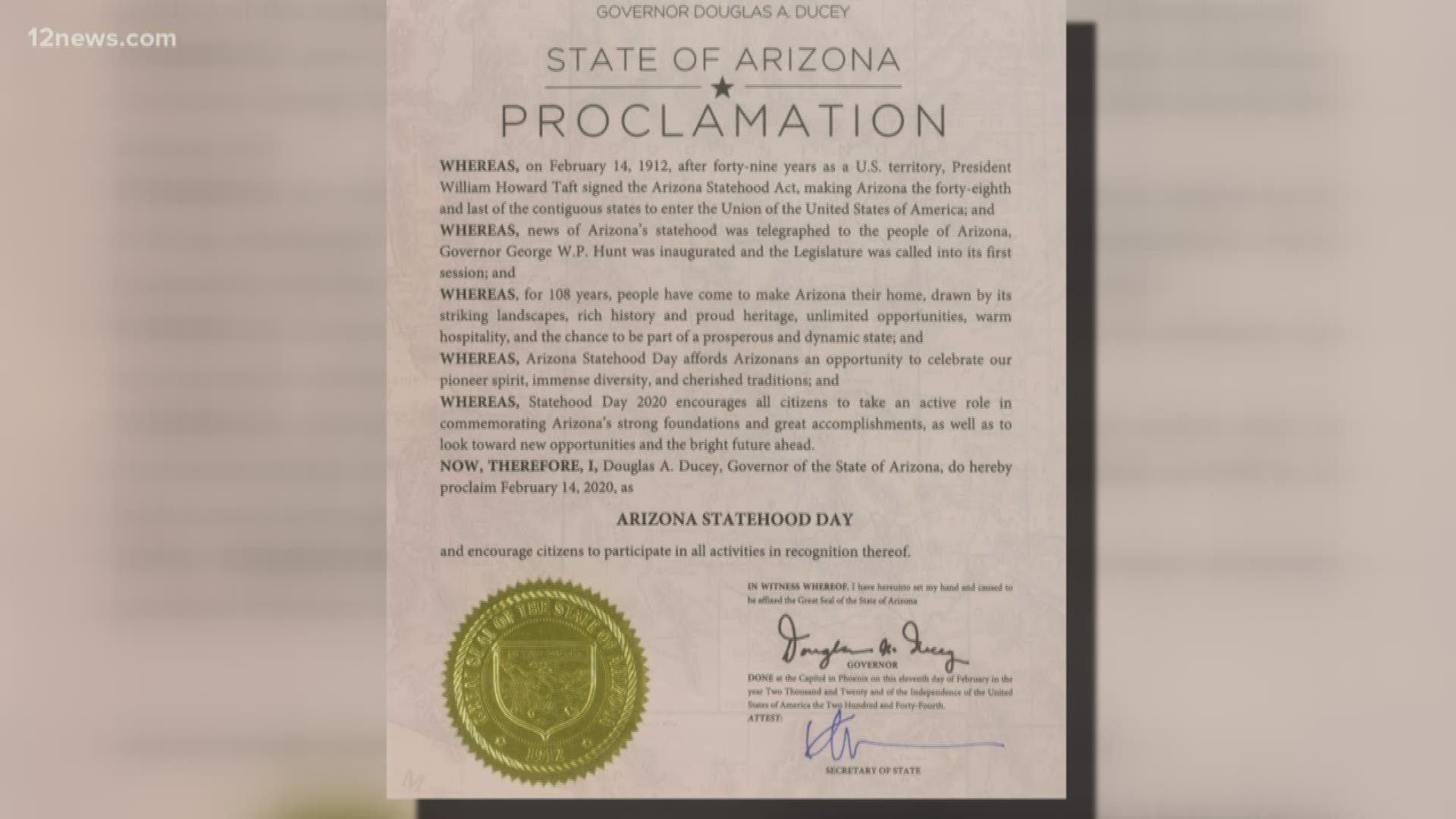ARIZONA, USA — Editor's note: The above video is from a previous broadcast.
A state’s journey to statehood is unique, there is no standard. Arizona’s journey to statehood is especially unique, however.
Arizona has the longest path to statehood of any state in the country, along with New Mexico and excluding current territories’ bids to become states. Why it took Arizona so long to become a state is, like most historical events, complicated and less than straightforward.
It’s an especially important question, though. Western states rich in natural resources like California, Oregon and Montana were quick to join the Union. But Arizona, a state also rich in natural resources and a landscape that is strategically advantageous to transporting goods, languished.
National and International Factors
Forces bigger than the United States government are partially to blame for this prolonged journey, but slow population growth, sympathizers of the Confederacy running the Territory of Arizona and some “radical” ideas about the state’s judiciary may all be contributing factors.
“You have to look at national and international context to really understand why [statehood] is not a straight shot,” said Jaynie Adams the curator for education at the Arizona Historical Society.
The land that would become Arizona comes onto the United States’ radar in the 1840s and 1850s. The varying political structures of Indigenous tribes, the Spanish monarchy, Mexican independence and Anglo-Americans pushing into the Southwest and bringing American democracy are all in play at this time.
“I think the layers of those political structures, the layers of colonialism and different colonial governments really add to why the path for Arizona statehood is so complex,” said Adams. “You have all of these different layers you have to contend with.”
The Population Problem
The Arizona Territory didn’t exist until 1863. Prior to 1863, Arizona and New Mexico were one territory known as the New Mexico Territory and the population was pretty sparse.
“If you weren’t in Tucson, Santa Fe or Albuquerque, there really wasn’t a dense population, at least not in the way the U.S. government formulated populations,” said Adams.
There were densely populated Indigenous communities and Mexican nationals who were granted United States citizenship when the Treaty of Guadalupe Hidalgo was signed to end the Mexican American War in 1848, but the federal government at the time was only interested in counting Anglo-Americans as part of the core population.
When statehood for Arizona was first proposed in the early 1900s, to make up for the lack of people in the territory, the idea of jointure was put forward. The land and people of Arizona and New Mexico would combine once again to form one state.
“People hated jointure for a lot of different reasons, particularly Arizonans hated jointure,” said Adams. “Unfortunately, a lot of those reasons are discriminatory. As the Anglo population in Arizona rises, the Anglo population in New Mexico isn’t rising at the same rate, New Mexico is much more Mexican, much more Indigenous. But that would have potentially solved the population problem."
The Confederate States of America
A lot of early political leaders in Arizona were Confederate sympathizers, some, at one point, had even been confederates themselves. These connections are often cited as a reason why Arizona’s statehood took so long, however, Adams has some doubts.
“I think it’s important to look at the national context,” said Adams. “I think that linkage is deeper than a lot of people are willing to consider, but at the same time, I also question how important that might have been given the escalation of legal, racial violence in the United State at the time that Arizona is becoming a state.”
Arizona’s Constitution
On June 20, 1910, Arizona was authorized to become a state by Congress. The authorization allowed Arizona to hold a constitutional convention so that the state’s constitution could be ratified by the residents.
When Arizona submitted its constitution, it included a provision that allowed for the recall of judges. President Howard Taft was opposed to this provision and vetoed Arizona’s statehood resolution on Aug. 15, 1911.
The next day, on Aug. 16, 1911, Congress passed a resolution admitting Arizona to the Union on the condition that the state removed the judiciary recall. President Taft approved this new resolution and on Jan. 6, 1912, Arizona’s residents voted to remove the recall provision.
On Feb. 14, 1912, President Taft signed the proclamation making Arizona the 48th state in the United States.
Arizona becoming a state
Historical context is relevant to President Taft eventually making Arizona a state. International and national factors intersect at the time Arizona becomes a state.
The Progressive Era is a major contributing factor. Women were granted the right to vote within months of Arizona becoming a state.
Women’s Suffrage was certainly part of the Progressive Era and Arizona gave women the right to vote within months of becoming a state but allowing women to vote also increased Arizona’s population numbers.
“I think the brewing conflict in Europe is part of it, I think the demand for copper is part of it, people are interested in the Southwest as tourists during this time period,” said Adams. “So, I think there are a lot of factors. History is neither quick nor straightforward. It’s messy, it’s complicated, it’s nuanced. It’s got all these moving parts.”
12 News Digital Exclusives
Go beyond the TV broadcast and learn more about unique Arizona stories on the 12 News YouTube channel. Subscribe for more digital-exclusive content!

